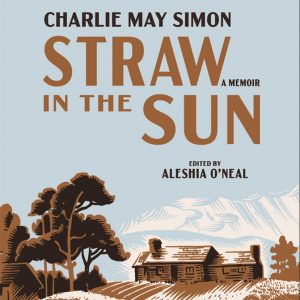calsfoundation@cals.org
Straw in the Sun
Straw in the Sun, published in 1945, was Charlie May Simon’s thirteenth book published by E. P. Dutton. Praised in critical reviews for its beautiful prose and depiction of Arkansas hill life, the memoir was so popular that it went through three printings in the year of its release. Beyond its relevance for a depiction of life in Arkansas during the Great Depression, Straw in the Sun serves as a historical narrative of homesteading in Perry County, Arkansas. In 1931, Simon claimed land high on a ridge overlooking the valley where her grandfather had settled after the Civil War. A theme woven throughout the memoir is the need for community, exemplified by Simon’s reliance on the generosity of neighbors to survive both drought and poverty. Her writing brings life to characters whose community existed near Cove Creek in the present-day Ouachita National Forest.
Although known as a children’s author, Simon published two memoirs, which allowed her membership in the elite PEN International organization. She corresponded with Jim Putnam, who was editor of Macmillan Publishing Company at the time her second memoir Johnswood was released in 1953 and served as general secretary of the PEN America center headquartered in New York City. His letter to her says: “I should like to propose you as a member of P.E.N. when we start up again in the fall. One is supposed to have written two books of reasonable distinction, and this indeed you have certainly done. Straw in the Sun is still a vivid memory to me.”
In Straw in the Sun, Charlie May Simon begins her narrative with the same device that she uses in Johnswood: an event occurs in the present that causes her to reminisce about the past, telling her tale in flashback. With Straw in the Sun, she and her husband John Gould Fletcher are returning to the site of the cabin homestead for a picnic lunch when a young hunter appears, telling the newcomers the local lore of the fire that destroyed the cabin. In Johnswood, Simon is selling her home and the hopeful buyer is asking questions. The device of a story within a story serves the author well, framing both memoirs with the catalyst of remembrance. Both narratives contain her frank honesty as she reveals events that occurred, yet Johnswood differs in a key element: although Fletcher has died, he is present in her memories of their life together in their home. The memoir serves as a eulogy to her husband.
In contrast, the presence of her first husband Howard Simon is never acknowledged in her memoir of homesteading in Perry County. Instead, he appears only in the article “Retreat to the Land: An Experience in Poverty,” published by Scribner’s Magazine in May 1933. Straw in the Sun references this article that launched the writing career of Charlie May Simon; when the funds from the sale of the story arrive, they provide necessities crucial for the survival of Simon and her hill community foster children, Vannie and Bob. Howard Simon also wrote of the homesteading experience, twenty-five years after the publication of Straw in the Sun, yet he describes a solitary experience that excludes Charlie May and the children who appeared at Rocky Crossing.
Almost a century after her homesteading experience that ended in 1935, her words speak truth and simplicity to a fast-paced, technological world. In 2025, Straw in the Sun was reprinted by the University of Arkansas Press.
For additional information:
O’Neal, Aleshia. “Charlie May Simon: Uncovering the Lost Voice of an Arkansas Author.” PhD diss., Arkansas State University, 2019.
“P.E.N. A World Association of Writers, Jim Putnam.” Charlie May Simon Papers (MS 41), Box 5, Folder 16. Special Collections Department, University Libraries. University of Memphis, Memphis, Tennessee.
Simon, Charlie May. Straw in the Sun. E. P. Dutton & Co., 1945.
Aleshia O’Neal
College of the Ozarks
 Literature and Authors
Literature and Authors World War II through the Faubus Era, 1941 through 1967
World War II through the Faubus Era, 1941 through 1967 Charlie May Simon
Charlie May Simon  Straw in the Sun
Straw in the Sun 



Comments
No comments on this entry yet.